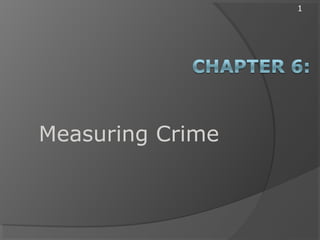
Measuring Crime: UCR, NCVS, Self-Report and Other Methods
- 2. •Crime can be a dependent variable in exploratory, descriptive, explanatory, and applied studies •Crime can also be an independent variable, as in a study of how crime affects fear and other attitudes •It can be both: drug use other offenses 2
- 3. •What offenses? •What units of analysis? •Specific entities about which researchers collect information •Offender, victim, offenses, incidents •What purpose? •Monitoring •Agency Accountability •Research 3
- 4. •Most widely used measures of crime are based on police records •Certain types are detected almost exclusively by observation (traffic and victimless offenses) •Most crimes reported by victim or witnesses •What crimes are not measured well by police records? •Assaults •Robberies 4
- 5. •Circa 1929, under FBI since 1930s •Originally, reporting voluntary, but now very common •Type I offenses (Index crimes/offenses): murder, rape, robbery, larceny, burglary, aggravated assault, motor vehicle theft and arson (added in 1979) •Type II offenses: a compilation of less serious crimes •Summary-based, group level unit of analysis 5
- 6. •The UCR is neither an exclusive nor an exhaustive measure •Not all law enforcement agencies submit complete reports to the FBI, and the quality of the data submitted varies •Summary-Based Measure of Crime •UCR data includes summary, or total, crime counts for reporting agencies (cities/counties) •UCR data are aggregates - cannot be used in descriptive or explanatory studies that focus on individual crimes, offenders, or victims 6
- 7. •Based on incidents as units of analysis •Supplementary Homicide Reports (SHR) •Police agencies submit detailed info about individual homicide incidents •Can conduct a variety of studies that examine individual events 7
- 8. •Joint effort by FBI and BJS to convert UCR to a NIBRS •NIBRS reports each crime incident rather than the total # of certain crimes for each Law Enforcement agency •Many features are reported individually about each incident, offenses, offenders, victims UCR NIBRS 8 Part I offenses 46 Group A offenses 8
- 9. •Hierarchy rule dropped •Victim type (individual, business, government, society/public) •Attempted/Completed •Drug-related offenses •Computers and crime •Quality control; states require certification 9
- 10. •Eliminating the hierarchy rule means offense classifications are mutually exclusive •But not exhaustive, not all crimes are counted •Creating auditing standards and requiring submission of data on computer readable media enhance reliability •Crimes are selectively reported to police and selectively recorded by police •Voluntary: no agency is required to submit crime reports to the FBI in any form 10
- 11. •Can obtain info on crimes not reported to police •Can measure incidents police may not officially record as crimes •Provides data on victims/offenders (individuals), and the incidents themselves (social artifacts) 11
- 12. •Since 1972 by Census Bureau •Sought to illuminate the “dark figure of unreported crime” •Longitudinal panel study: households agree to participated for 3 years (7 interviews; one every 6 months) and then replaced •Does not measure all crime •Respondents are asked screening questions 12
- 13. •Measures both reported and unreported crime •Independent of changes in reporting •More information about how crime impacted victim than UCR •Provides more victim characteristics than UCR 13
- 14. •Telescoping incident dates •Faulty memory •Little information on offenders •No information on CJS response if reported •Excludes crimes against commercial establishments •Only includes residents of US 14
- 15. •Sought to improve measurement of domestic violence and sexual assault •Revised screening questions and added cues to help respondents recall and distinguish minor incidents •More direct questions on rape and other sexual crimes •Greater attention to measuring victimizations by someone the respondent knows •Gradual increase of telephone interviews to replace in-person interviews 15
- 16. •First Development in late 1960’s •A series of city-level surveys by the Census Bureau •1998 BJS and the Office of Community Oriented Policing Services (COPS) launched pilot surveys in 12 large and medium-sized cities •Jointly developed a guidebook and software so that local law enforcement agencies and other groups can conduct their own community surveys 16
- 17. •Crimes Known to Police: •UCR •SHR •NIBRS •Victim Surveys •NCVS •Community Victimization Surveys 17
- 18. •Delinquency, "victimless" crimes, and crimes rarely observed or reported to police may be measured by self-report surveys •Example: prostitution, drug abuse, public order, shoplifting, drunk driving •Two ongoing self-report studies •National Survey on Drug Use and Health (NSDUH) •Monitor The Future (MTF) 18
- 19. •Based on a national sample of households •Conducted since 1971; 2004 sample had 68,000 individuals •Includes questions to distinguish between lifetime use, current use, and heavy use •Encourages candid responses via procedures •Includes residents of college dorms, rooming houses, and homeless shelters 19
- 20. •Conducted since 1975 by the National Institute on Drug Abuse •Includes several samples of high school students and others, totaling about 50,000 respondents each year •Questions concern self-reported use of alcohol, tobacco, illegal drugs, delinquency, other acts •A subset of 2,400 MTF respondents receive follow-up questionnaire 20
- 21. •Surveillance systems have been developed to obtain alternative measures of drug use •Arrestee Drug Abuse Monitoring (ADAM) – provides ongoing assessment of drug use among arrestees •Drug Abuse Warning Network (DAWN) – collects emergency medical treatment reports for “drug episodes” from a sample of hospitals 21
- 22. •Local Crime and Self-Report Surveys •e.g., any purpose! •Incident-Based Crime Reports •e.g., Newark PD vehicle theft •Observing Crime •e.g., shoplifting, bar drinking and violence 22
- 23. •UCR & SHR: best for murder and crimes in which the victim is a business or commercial establishment •NCVS: best for crimes against persons or households that are not reported to police •Self-report surveys: best at measuring crimes that do not have readily identifiable victims and that are less often observed by or reported to police 23